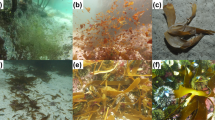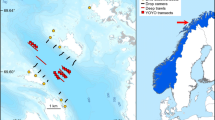Abstract
With the increasing imperative for societies to act to curb climate change by increasing carbon stores and sinks, it has become critical to understand how organic carbon is produced, released, transformed, transported, and sequestered within and across ecosystems. In freshwater and open-ocean systems, shredders play a significant and well-known role in transforming and mobilizing carbon, but their role in the carbon cycle of coastal ecosystems is largely unknown. Marine plants such as kelps produce vast amounts of detritus, which can be captured and consumed by shedders as it traverses the seafloor. We measured capture and consumption rates of kelp detritus by sea urchins across four sampling periods and over a range of kelp detritus production rates and sea urchin densities, in northern Norway. When sea urchin densities exceeded 4 m−2, the sea urchins captured and consumed a high percentage (ca. 80%) of kelp detritus on shallow reefs. We calculated that between 1.3 and 10.8 kg of kelp m−2 are shredded annually from these reefs. We used a hydrodynamic dispersal model to show that transformation of kelp blades to sea urchin feces increased its export distance fourfold. Our findings show that sea urchins can accelerate and extend the export of carbon to neighboring areas. This collector–shredder pathway could represent a significant flow of small particulate carbon from kelp forests to deep-sea areas, where it can subsidize benthic communities or contribute to the global carbon sink.

Photographs taken by T Wernberg and K Filbee-Dexter







Similar content being viewed by others
References
Abdullah M, Fredriksen S, Christie H (2017) The impact of the kelp (Laminaria hyperborea) forest on the organic matter content in sediment of the west coast of Norway. Mar Biol Res 13:151–160
Bekkby T, Moy FE, Olsen H et al (2013) The Norwegian Programme for Mapping of Marine Habitats—providing knowledge and maps for ICZMP. Global challenges in integrated coastal zone management. Wiley, Oxford, pp 19–30
Britton-Simmons KH, Rhoades AL, Pacunski RE et al (2012) Habitat and bathymetry influence the landscape-scale distribution and abundance of drift macrophytes and associated invertebrates. Limnol Oceanogr 57:176–184. https://doi.org/10.4319/lo.2012.57.1.0176
Canadell JG, Le Quéré C, Raupach MR et al (2007) Contributions to accelerating atmospheric CO2 growth from economic activity, carbon intensity, and efficiency of natural sinks. Proc Natl Acad Sci USA 104:18866–18870. https://doi.org/10.1073/pnas.0702737104
Christie H, Gundersen H, Rinde E et al (2019) Can multitrophic interactions and ocean warming influence large-scale kelp recovery? Ecol Evol 9:2847–2862. https://doi.org/10.1002/ece3.4963
Dean TA, Bodkin JL, Jewett SC et al (2000) Changes in sea urchins and kelp following a reduction in sea otter density as a result of the Exxon Valdez oil spill. Mar Ecol Prog Ser 199:281–291
Fagerli C, Norderhaug K, Christie H (2013) Lack of sea urchin settlement may explain kelp forest recovery in overgrazed areas in Norway. Mar Ecol Prog Ser 488:119–132. https://doi.org/10.3354/meps10413
Fagerli C, Norderhaug KM, Christie H et al (2014) Predators of the destructive sea urchin grazer (Strongylocentrotus droebachiensis) on the Norwegian coast. Mar Ecol Prog Ser 502:207–218
Feehan C, Scheibling R (2014) Disease as a control of sea urchin populations in Nova Scotian kelp beds. Mar Ecol Prog Ser 500:149–158. https://doi.org/10.3354/meps10700
Filbee-Dexter K, Scheibling RE (2012) Hurricane-mediated defoliation of kelp beds and pulsed delivery of kelp detritus to offshore sedimentary habitats. Mar Ecol Prog Ser 455:51–64. https://doi.org/10.3354/meps09667
Filbee-Dexter K, Scheibling RE (2014a) Detrital kelp subsidy supports high reproductive condition of deep-living sea urchins in a sedimentary basin. Aquat Biol 23:71–86. https://doi.org/10.3354/ab00607
Filbee-Dexter K, Scheibling RE (2014b) Sea urchin barrens as alternative stable states of collapsed kelp ecosystems. Mar Ecol Prog Ser 495:1–25. https://doi.org/10.3354/meps10573
Filbee-Dexter K, Scheibling RE (2016) Spatial patterns and predictors of drift algal subsidy in deep subtidal environments. Estuaries Coasts 39:1724–1734. https://doi.org/10.1007/s12237-016-0101-5
Filbee-Dexter K, Wernberg T, Norderhaug KM et al (2018) Movement of pulsed resource subsidies from kelp forests to deep fjords. Oecologia 187:291–304. https://doi.org/10.1007/s00442-018-4121-7
Filbee-Dexter K, Wernberg T, Fredriksen S et al (2019) Arctic kelp forests: diversity, resilience and future. Glob Planet Change 172:1–14. https://doi.org/10.1016/j.gloplacha.2018.09.005
Haidvogel DB, Arango H, Budgell WP et al (2008) Ocean forecasting in terrain-following coordinates: formulation and skill assessment of the Regional Ocean Modeling System. J Comput Phys 227:3595–3624. https://doi.org/10.1016/j.jcp.2007.06.016
Hansen B, Fotel FL, Jensen NJ, Madsen SD (1996) Bacteria associated with a marine planktonic copepod in culture. II. Degradation of fecal pellets produced on a diatom, a nanoflagellate or a dinoflagellate diet. J Plankton Res 18:275–288. https://doi.org/10.1093/plankt/18.2.275
Harrold C, Reed DC (1985) Food availability, sea urchin grazing, and kelp forest community structure. Ecology 66:1160–1169. https://doi.org/10.2307/1939168
Heck KL, Carruthers TJB, Duarte CM et al (2008) Trophic transfers from seagrass meadows subsidize diverse marine and terrestrial consumers. Ecosystems 11:1198–1210. https://doi.org/10.1007/s10021-008-9155-y
Howard J, Sutton-Grier A, Herr D et al (2017) Clarifying the role of coastal and marine systems in climate mitigation. Front Ecol Environ 15:42–50. https://doi.org/10.1002/fee.1451
IPCC (2014) Climate change 2014: synthesis report. Contribution of working groups I, II and III to the fifth assessment report of the intergovernmental panel on climate change [Core Writing Team, RK Pachauri and LA Meyer (eds.)]. IPCC, Geneva
Johnson CR, Mann KH (1986) The importance of plant defence abilities to the structure of subtidal seaweed communities: the kelp Laminaria longicruris de la Pylaie survives grazing by the snail Lacuna vincta (Montagu) at high population densities. J Exp Mar Bio Ecol 97:231–267. https://doi.org/10.1016/0022-0981(86)90244-3
Krause-Jensen D, Duarte CM (2016) Substantial role of macroalgae in marine carbon sequestration. Nat Geosci 9:737–742. https://doi.org/10.1038/ngeo2790
Krause-Jensen D, Lavery P, Serrano O et al (2018) Sequestration of macroalgal carbon: the elephant in the Blue Carbon room. Biol Lett 14:20180236. https://doi.org/10.1098/rsbl.2018.0236
Krumhansl K, Scheibling R (2012) Production and fate of kelp detritus. Mar Ecol Prog Ser 467:281–302. https://doi.org/10.3354/meps09940
Krumhansl KA, Lauzon-Guay J-S, Scheibling RE (2014) Modeling effects of climate change and phase shifts on detrital production of a kelp bed. Ecology 95:763–774
Larson BR, Vadas RL, Keser M (1980) Feeding and nutritional ecology of the sea urchin Strongylocentrotus drobachiensis in Maine, USA. Mar Biol 59:49–62. https://doi.org/10.1007/BF00396982
Lauzon-Guay J-S, Scheibling RE (2007) Seasonal variation in movement, aggregation and destructive grazing of the green sea urchin (Strongylocentrotus droebachiensis) in relation to wave action and sea temperature. Mar Biol 151:2109–2118. https://doi.org/10.1007/s00227-007-0668-2
Lauzon-Guay J, Scheibling R (2010) Spatial dynamics, ecological thresholds and phase shifts: modelling grazer aggregation and gap formation in kelp beds. Mar Ecol Prog Ser 403:29–41. https://doi.org/10.3354/meps08494
Leclerc J, Riera P, Leroux C et al (2013) Temporal variation in organic matter supply in kelp forests: linking structure to trophic functioning. Mar Ecol Prog Ser 494:87–105. https://doi.org/10.3354/meps10564
Ling SD, Johnson CR, Ridgeway K et al (2009) Climate-driven range extension of a sea urchin: inferring future trends by analysis of recent population dynamics. Glob Chang Biol 15:719–731. https://doi.org/10.1111/j.1365-2486.2008.01734.x
Mamelona J, Pelletier É (2005) Green urchin as a significant source of fecal particulate organic matter within nearshore benthic ecosystems. J Exp Mar Bio Ecol 314:163–174. https://doi.org/10.1016/J.JEMBE.2004.08.026
Mann K (1973) Seaweeds: their productivity and strategy for growth. Science 182:975–981. https://doi.org/10.1126/science.155.3758.81
Muggeo VMR (2017) Regression models with break-points/change-points estimation
Norderhaug KM, Christie HC (2009) Sea urchin grazing and kelp re-vegetation in the NE Atlantic. Mar Biol Res 5:515–528. https://doi.org/10.1080/17451000902932985
Orth RJ, Carruthers TJB, Dennison WC et al (2006) A global crisis for seagrass e cosystems. Bioscience 56:987–996. https://doi.org/10.1641/0006-3568(2006)56%5b987:agcfse%5d2.0.co;2
Pedersen MF, Filbee-Dexter K, Fagerli CW et al (2019) Detrital carbon production and export in high latitude kelp forests. Oecologia. https://doi.org/10.1007/s00442-019-04573-z
Peduzzi P, Herndl GJ (1986) Role of bacteria in decomposition of faecal pellets egested by the epiphyte-grazing gastropod Gibbula umbilicaris. Mar Biol 92:417–424. https://doi.org/10.1007/BF00392682
Pinheiro J, Bates D, DebRoy S et al (2019) nlme: linear and nonlinear mixed effects models. R package version 3.1-142
Povero P, Misic C, Ossola C et al (2003) The trophic role and ecological implications of oval faecal pellets in Terra Nova Bay (Ross Sea). Polar Biol 26:302–310. https://doi.org/10.1007/s00300-003-0485-0
Queirós AM, Stephens N, Widdicombe S et al (2019) Connected macroalgal-sediment systems: blue carbon and food webs in the deep coastal ocean. Ecol Monogr. https://doi.org/10.1002/ecm.1366
Renaud PE, Løkken TS, Jørgensen LL et al (2015) Macroalgal detritus and food-web subsidies along an Arctic fjord depth-gradient. Front Mar Sci 2:31. https://doi.org/10.3389/fmars.2015.00031
Rogers-Bennett L, Catton CA (2019) Marine heat wave and multiple stressors tip bull kelp forest to sea urchin barrens. Sci Rep 9:15050. https://doi.org/10.1038/s41598-019-51114-y
Sauchyn L, Scheibling R (2009) Degradation of sea urchin feces in a rocky subtidal ecosystem: implications for nutrient cycling and energy flow. Aquat Biol 6:99–108. https://doi.org/10.3354/ab00171
Schram JB, Kobelt JN, Dethier MN, Galloway AWE (2018) Trophic transfer of macroalgal fatty acids in two urchin species: digestion, egestion, and tissue building. Front Ecol Evol 6:83. https://doi.org/10.3389/fevo.2018.00083
Shchepetkin AF, McWilliams JC (2005) The regional oceanic modeling system (ROMS): a split-explicit, free-surface, topography-following-coordinate oceanic model. Ocean Model 9:347–404. https://doi.org/10.1016/J.OCEMOD.2004.08.002
Smale DA, Moore PJ, Queirós AM et al (2018) Appreciating interconnectivity between habitats is key to blue carbon management. Front Ecol Environ 16:71–73. https://doi.org/10.1002/fee.1765
Smith RW, Bianchi TS, Allison M et al (2015) High rates of organic carbon burial in fjord sediments globally. Nat Geosci 8:450–453. https://doi.org/10.1038/ngeo2421
Steneck RS, Graham MH, Bourque BJ et al (2002) Kelp forest ecosystems: biodiversity, stability, resilience and future. Environ Conserv 29:436–459. https://doi.org/10.1017/S0376892902000322
Thor P, Dam H, Rogers D (2003) Fate of organic carbon released from decomposing copepod fecal pellets in relation to bacterial production and ectoenzymatic activity. Aquat Microb Ecol 33:279–288. https://doi.org/10.3354/ame033279
Vanderklift MA, Wernberg T (2008) Detached kelps from distant sources are a food subsidy for sea urchins. Oecologia 157:327–335. https://doi.org/10.1007/s00442-008-1061-7
Vetter EW, Dayton PK (1998) Macrofaunal communities within and adjacent to a detritus-rich submarine canyon system. Deep Sea Res Part II Top Stud Oceanogr 45:25–54. https://doi.org/10.1016/S0967-0645(97)00048-9
Wernberg T, Filbee-Dexter K (2018) Grazers extend blue carbon transfer by slowing sinking speeds of kelp detritus. Sci Rep 8:17180
Wernberg T, Krumhansl KA, Filbee-Dexter K, Pedersen MF (2019) Status and trends for the world’s kelp forests. In: Sheppard C (ed) World seas: an environmental evaluation, vol III: ecological issues and environmental impacts. Academic Press, New York
Wotton RS, Malmqvist B (2001) Feces in aquatic ecosystems: feeding animals transform organic matter into fecal pellets, which sink or are transported horizontally by currents; these fluxes relocate organic matter in aquatic ecosystems. Bioscience 51:537–544. https://doi.org/10.1641/0006-3568(2001)051%5b0537:fiae%5d2.0.co;2
Yorke CE, Page HM, Miller RJ (2019) Sea urchins mediate the availability of kelp detritus to benthic consumers. Proc R Soc B Biol Sci 286:20190846. https://doi.org/10.1098/rspb.2019.0846
Acknowledgements
This work was funded by the Norwegian Research Council through the KELPEX project (NRC Grant no. 255085). The modeling component was funded by the Norwegian Research Council through the KELPFATE project (NRC Grant no. 160016/F40) and by the Norwegian Blue Forest Network through the Norwegian Institute for Water Research’s KELPFLOAT project (NIVA project no. 180144.211). TW received funding from The Australian Research Council (DP170100023). Sabine Popp, Camilla with Fagerli, Eva Ramirez-Llodra, and Nicolai Lond Frisk assisted with field work. Eva Ramirez-Llodra and Torstein Pedersen provided insightful comments and edits to the manuscript.
Author information
Authors and Affiliations
Contributions
KFD, MP, TW, KMN, and SF conceived and designed the study and conducted the fieldwork. ER, TK, KFD and JA developed and analyzed the modelling component. KFD analyzed the field data and led the writing of the manuscript. All authors discussed the results and contributed to the writing.
Corresponding author
Additional information
Communicated by James Fourqurean.
Electronic supplementary material
Below is the link to the electronic supplementary material.
Rights and permissions
About this article
Cite this article
Filbee-Dexter, K., Pedersen, M.F., Fredriksen, S. et al. Carbon export is facilitated by sea urchins transforming kelp detritus. Oecologia 192, 213–225 (2020). https://doi.org/10.1007/s00442-019-04571-1
Received:
Accepted:
Published:
Issue Date:
DOI: https://doi.org/10.1007/s00442-019-04571-1




